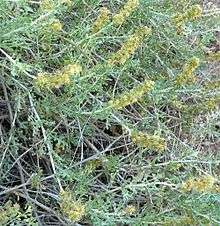Ambrosia dumosa
| Ambrosia dumosa | |
|---|---|
 | |
| Scientific classification | |
| Kingdom: | Plantae |
| Clade: | Angiosperms |
| Clade: | Eudicots |
| Clade: | Asterids |
| Order: | Asterales |
| Family: | Asteraceae |
| Genus: | Ambrosia |
| Species: | A. dumosa |
| Binomial name | |
| Ambrosia dumosa (A.Gray) W.W.Payne | |
| Synonyms[1][2] | |
| |
Ambrosia dumosa, the burro-weed or white bursage, a North American species of plants in the sunflower family. It is a common constituent of the creosote-bush scrub community throughout the Mojave desert of California, Nevada, and Utah and the Sonoran Desert of Arizona and northwestern Mexico (Baja California, Baja California Sur, Sonora, Chihuahua).[3][4][5][6]
Ambrosia dumosa has been studied to determine allelopathic interactions with creosote bush, Larrea tridentata, which produces a chemical that inhibits the growth of A. dumosa. Other studies have suggested that A. dumosa roots produce a chemical that causes them to grow away from conspecific roots, preventing competition for water resources. In addition to burrow-weed, A. dumosa is also commonly called bur sage, burro weed, and burro bush.
Description
Ambrosia dumosa, a form of ragweed, is a highly branched shrub 20 to 90 cm in height. The younger stems are covered with soft gray-white hairs. Approximately obovate leaves are 1 to 3 times pinnately compound or deeply lobed and generally clustered on short branches. The leaves are 0.5 to 4 cm long and also covered in soft gray-white hairs.[3]
Its inflorescence is yellow with staminate and pistillate headson a single plant (monoecious). Staminate heads have many flowers and are 3 to 5 mm in diameter with a 5 to 8 lobed involucre. Pistillate heads are 2 flowered and lack corollas.[3]
Ambrosia dumosa has spherical bur-like fruits ranging in color from golden to purple to brown. Along with microscopic hairs, the fruit has 12 to 35 flat and straight spines which are 5 to 9 mm in length and scattered over the surface.[7][3]
Ambrosia dumosa becomes dormant during drought, losing all of its leaves to prevent water loss by transpiration; drought deciduous. During this time it can still be recognized by the presence of longitudinal stripes on smaller stems.[7]
Like other types of Ambrosia this is a ragweed, wind blown pollen from burro-weed can cause serious allergic reactions. Increasing cases in Mojave Desert as population grows from Joshua Tree, CA to Las Vegas, NV.
References
- ↑ Tropicos, Ambrosia dumosa (A. Gray) W.W. Payne
- ↑ The Plant List, Ambrosia dumosa (A.Gray) W.W.Payne
- 1 2 3 4 Flora of North America Vol. 21 Page 13 Bursage Ambrosia dumosa (A. Gray) W. W. Payne, J. Arnold Arbor. 45: 422. 1964.
- ↑ Biota of North America Program 2014 county distribution map
- ↑ Calflora taxon report, University of California, Ambrosia dumosa (A. Gray) Payne Burrobush, burro weed, white bursage
- ↑ Tropicos, specimen listing for Ambrosia dumosa (A. Gray) W.W. Payne
- 1 2 Allen A.Schoenerr, Allen A. 1992. A Natural History of California. Berkeley: University of California Press. ISBN 0-520-06922-6
- Jepson Manual Treatment: Ambrosia dumosa
- C.Michael Hogan, species editor. 2010. Ambrosia dumosa. Encyclopedia of Life
External links
- Jepson Manual Treatment: Ambrosia dumosa
- Lady Bird Johnson Wildflower Center Native Plant Information Network (NPIN), University of Texas
- Ambrosia dumosa — Calphotos Photo gallery, University of California
| Wikimedia Commons has media related to Ambrosia dumosa. |